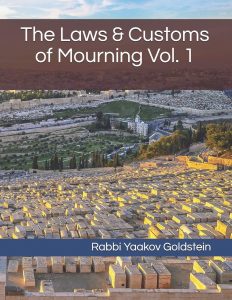1. When does the Shiva begin?[1]
The transition from the state of Onen to the state of Aveilus begins by “Setimas Hagolel”[2], which is immediately after the body is buried and the grave is closed with earth.[3] Once the earth has been placed over the body/coffin in a way that one can no longer see the body/coffin, the Shiva officially begins.[4] [Nonetheless, there are cases of exception, explained throughout Halacha’s 4-12, in which the Shiva may begin some time before or after the burial. An example of such a case is if the burial took place during Chol Hamoed, in which case Shiva only begins after Yom Tov. See there and in Chapter 27 Halacha 5 for the full list of cases.]
Began Shiva before burial:[5] If one began the mourning prior to the completion of the burial, he must restart the mourning after the completion of the burial. [Thus, if he began mourning prior to nightfall on Sunday, and then discovered that the burial was not complete until after nightfall, he begins counting Shiva from Sunday night. If, however, he discovered the burial was completed before nightfall of Sunday, then even though he accidently began keeping it before the burial was complete, he counts Shiva from Sunday.[6]]
Another relative passed away within Shiva:[7] If within the Shiva for one relative, another relative passed away, one begins to count the Shiva for second relative after the burial is complete, even if it is still within the Shiva of the first relative. [Thus, if on the 3rd day of Shiva a second relative passed away and was buried, one does not wait until the end of Shiva for the first relative to begin the Shiva for the second relative, but rather has the 3rd day and onwards count for both relatives, and hence sits Shiva for a total of nine days.] If two relatives passed away and were buried on the same day, then one sits Shiva and Shloshim simultaneously for both relatives starting from the day of burial.[8]
What is the law if one sat Shiva for the wrong relative, such as if he later discovered that in truth it was a different relative who died? See Chapter 12 Halacha 1A!
________________________________________________________________________
[1] See 375:1; Nitei Gavriel 133:1; See Encyclopedia Talmudit Erech Aveilus p. 61
[2] Michaber 375:1; Rambam 1:2; Rebbe Yehoshua in Moed Katan 27a and Semachos 11 that we follow Setimas Hagolel
Other Talmudic opinions: In the Talmud, some held that the start of the Aveilus is as soon as the body left the home for the funeral. [Rebbe Eliezer in Moed Katan 27a and Semachos 11]
[3] Michaber 375:1; 2nd opinion in Tur 375:1; Rabbeinu Tam on Moed Katan 26a; Rosh Moed Katan 3:35; Geonim; Chochmas Adam 162:2; Kitzur SHU”A 204:1; All Poskim in next footnote! See Admur 71:1 regarding the end of Aninus
Other opinions: Some Poskim rule that Setimas Hagolel, which signifies the start of Shiva, is when the Aron is closed with nails and not later on when the body is buried. [1st opinion in Tur ibid; Rashi Moed Katan 27a as explained in Ramban brought in Tur ibid; See Taz 375:1; Shach 373:11; Beis Yosef 375:2; See Aruch Hashulchan 375:1 who explains that in truth there is no dispute] Other Poskim rule that Setgimas Hagolel is defined as the placing of the foundation stone for the tombstone. [Rabbeinu Tam in Tosafos Kesubos 4b]
[4] Taz 375:1 “So long as the Aron is revealed without any earth on top of it”; Aruch Hashulchan 375:1 “When the Aron can no longer be seen”; Beis Lechem Yehuda 375; Halef Lecha Shlomo Y.D. 318; Kinas Sofrim Hashmatos 318; Nitei Gavriel 133:1 footnote 1; See regarding Aninus for a similar ruling: Admur 71:1 “However, as soon as they begin throwing the earth on the body, they are obligated in Shema”; M”A 71:1; Kitzur SHU”A 196:3; Nitei Gavriel 77:12 [However, see Nitei Gavriel 133:1 footnote 1 that in truth the end of Aninus does not signify the start of Aveilus, as Aninus ends when the earth is begun to be thrown on the grave, while Aveilus begins only when the entire body/casket is covered.] See Daas Torah 396 that the mound made on top of the grave is also included in the completion of burial
[5] Rama 375:1; Michaber 375:6; Rosh 27; Chochmas Adam 162:2; Kitzur SHU”A 204:2; Aruch Hashulchan 375:6; Nitei Gavriel 133:5
[6] Pischeiy Teshuvah 375:1 in name of Derech Chaim; Kitzur SHU”A 204:2; Nitei Gavriel 133:6
[7] Michaber 375:10; 402:9
[8] Michaber 402:9


Leave A Comment?
You must be logged in to post a comment.